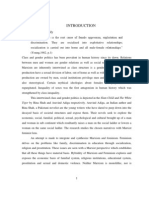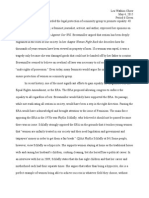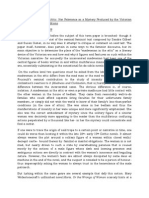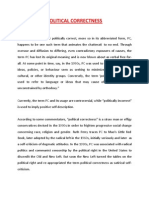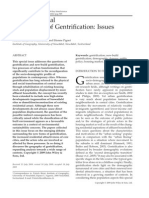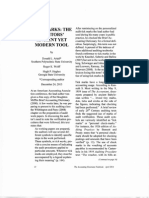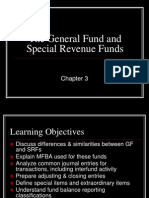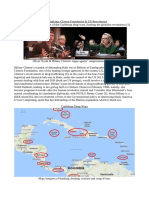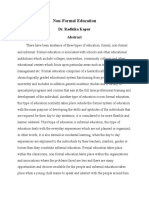Gentrification and Displacement: "Urban Altruism" - Calvin College - Spring 2006 WWW - Calvin.edu/ Jks4/city
Gentrification and Displacement: "Urban Altruism" - Calvin College - Spring 2006 WWW - Calvin.edu/ Jks4/city
Uploaded by
Alysha Harvey EACopyright:
Available Formats
Gentrification and Displacement: "Urban Altruism" - Calvin College - Spring 2006 WWW - Calvin.edu/ Jks4/city
Gentrification and Displacement: "Urban Altruism" - Calvin College - Spring 2006 WWW - Calvin.edu/ Jks4/city
Uploaded by
Alysha Harvey EAOriginal Description:
Original Title
Copyright
Available Formats
Share this document
Did you find this document useful?
Is this content inappropriate?
Copyright:
Available Formats
Gentrification and Displacement: "Urban Altruism" - Calvin College - Spring 2006 WWW - Calvin.edu/ Jks4/city
Gentrification and Displacement: "Urban Altruism" - Calvin College - Spring 2006 WWW - Calvin.edu/ Jks4/city
Uploaded by
Alysha Harvey EACopyright:
Available Formats
Urban Altruism | Calvin College | Spring 2006 www.calvin.
edu/~jks4/city
Gentrification and Displacement
Janelle Vandergrift
Gentrification is a word that has become commonplace over the last several years. And yet, it is not necessarily understood completely and has often become synonymous with displacement. A common understanding of the word may include the assumption that urban areas are initially inhabited by minority populations and are stereotyped as bad neighborhoods with run down houses and unemployed people. White, rich people then move in and improve the aesthetic conditions of the neighborhood and then the original residents, who eventually are unable to keep up with tax costs and recognize that culture of their old neighborhood is lost, then move elsewhere. Many questions remain from this colloquial definition and social scientists have discussed what exactly is meant by gentrification, what motivates people to gentrify into neighborhoods, if gentrification is synonymous with displacement and what alternatives there are to protect the status of the original residents of neighborhoods and encourage diversity. Although the intentions of cleaning up an urban space and the idea of restoring abandoned territory through residential means may be viewed as altruistic, it is an ongoing challenge for developers to consider what exactly causes the existing disparity and lack of diversity on a systemic level. The world gentrification has historic and social significance, which is important for understanding various definitions. Redfern suggests that the term gentrification comes from the world gentry which describes the non-aristocratic English rural land-owning classes (Redfern, 2003, 2361). If we understand gentrification as moving into an urban area, it seems somewhat odd that the word has rural connotations. Williams discusses the 19th century description of rural society in Jane Austen novels as a society in which her rural-dwelling characters refer only to members of their own social class as their neighbors (Redfern, 2003, 2362). Here, the reality
Urban Altruism | Calvin College | Spring 2006 www.calvin.edu/~jks4/city
of country life is ignored; gentrification implies the class replacement of those who live in the city by those who create an identity in the city, which the upper class fails to interact with those around them (Redfern, 2362). Using the definition suggested by Redfern, it is easy to understand why we use gentrification as nearly synonymous with displacement: gentrifiers are oblivious and ignorant to the realities of people that inhabit the neighborhood that they come into. The original residents are, in a sense, replaced because of increase in property, tax and the destruction of a social community and then they move out of the neighborhood (Keating, 2000, 384). Many sources of literature recognize the variety of assumptions about the term gentrification and have tried to provide working definitions, allowing for a better analysis and understanding of the phenomenon. Ruth Glass was one of the first to use this word in 1964 to describe how gentrification was displacing working class people (Atkinson, 2003, 2350). Van Criekingen and Decroly describe gentrification as a process sometimes labeled yuppification the metamorphosis of deprived inner-city neighborhoods into new prestigious residential and consumption areas taken up by a new class of highly skilled and highly paid residents, typically business service professionals living in small-sized, non-familial households that brings displacement of the neighborhoods initial population (2003, 2452). Bostic and Martin define gentrification as a neighborhood evolutionary process in which affluent, usually young, households move into and upgrade distressed neighborhoods, with many of the neighborhoods original residents being displaced It is common for discussions of gentrification also to add a racial dimension to gentrification that follows a well-defined pattern (2003, 2427). These definitions of gentrification, as well as many others, typically include in their definitions an economically run-down inner city; young, wealthy professionals moving in and upgrading; and finally, the process displacing initial populations. Some literature would label generally accepted definitions as too simplistic or too specific. Van Criekingen and Decroly credit Beauregard 1986 for stating that gentrification is a
Urban Altruism | Calvin College | Spring 2006 www.calvin.edu/~jks4/city
chaotic concept of many interrelated events and processes that have been aggregated under a single (ideological) label and have been assumed to require a single causal explanation (2003, 2451). Yet others, like Bondi, label gentrification as simply a process of transition, implying an expected process, which presents an understanding that sets itself apart from the automatic criticism that often accompanies the word gentrification (Redfern, 2003, 2351). Regardless of such controversy, social scientists typically agree that there has been a change in many inner-city neighborhoods and displacement has been an issue that has been discussed as early as the 1970s (Bostic and Martin, 2003, 2427). Gentrification as a social pattern is still a current issue; Atkinson makes the point that gentrification continues to be a problem of definition, theorization, and social cost as well as a significant challenge for public policy (Atkinson, 2003, 2349). Van Criekingen and Decroly believe it is important to make a distinction between the different types of gentrification and have named and described three different types. First of all, they see the general definition of gentrification as yuppification, or the process of young professionals moving into urban neighborhoods, and a correlation with an emergence of a new middle-class that is bound to corporate and financially high-end activities. Second, marginal gentrification is described as distinct from mainstream gentrification that is often by transient renters or temporary residents who will eventually return to suburbia after they have a family. Finally, upgrading and incumbent upgrading is achieved through long term residents that have moderate income and try to improve their housing and implies little population change (Van Criekingen, Decroly, 2003, 2454). Another differentiation by Freeman suggests that perhaps education is a better marker of gentrifiers as opposed to income levels because young artists and professionals often pioneer gentrification and are not considered wealthy (Freeman, 2005, 471).
Urban Altruism | Calvin College | Spring 2006 www.calvin.edu/~jks4/city
Making these differentiations allows for a more pointed critique and a better-formulated response to those different groups and their motivations. Unfortunately, this kind of breakdown is not common language when speaking about gentrification and all groups are most often seen as one in the same. Additionally, literature often does not refer to any sort of distinction between class level and income level, which is important in evaluating the effects of gentrification. Literature on the motivating factors of gentrification has received much speculation in current literature. It is suggested that people identify themselves with particular neighborhoods and look for where people like us will live and where they can participate in the cultural milieu and occupational influences (Butler, Robson, 2003, 1792, 93). Rofe proposes that the gentrifying community is generally one that identifies as wanting to be part of a global community and desiring to be less bound by typical assumptions of which neighborhoods their class and race should reside (Rofe, 2003, 2516). The idea of wanting to move and inhabit a place where one can feel part of a global community implies the idea that face to face communities are the most legitimate forms of community. Yet, gentrified communities are often referred to in literature as comprised of white, professional people with little diversity racially or economically, which seems contrary to the realty of a global world. Rofe suggests that this global community that people desire is often a collective imagining of the community they desire and creates an elite class without any sort of diversity economically, racially or ethnically (Rofe, 2003, 2518). Redfern suggests gentrifiers, suburbanites, and displacees are primarily motivated to inhabit certain neighborhoods for the reason of defining and preserving identity (2003, 2366). There is a component of fashion for gentrifiers and the usage of housing as a status symbol; the process of gentrifying could be seen as the out-working of an identity crisis in which gentrifiers have the power and the privilege of re-asserting themselves as not sub-urban (Redfern, 2003,
Urban Altruism | Calvin College | Spring 2006 www.calvin.edu/~jks4/city
2355; Butler, Robson, 2003, 1792). Like fashion in clothing, housing has become the struggle of defining oneself to receive recognition, honor and respect. The difference between gentrifiers and displacees is the financial ability to buy the identity that will provide them with exact recognition, honor and respect that they desire (Redfern, 2003, 2360). There are differences in opinion as to whether gentrification in urban neighborhoods is savior or whether it is a destroyer of central city vitality (Atkinson, 2003, 2350). Often the debate is reduced to the side that wants to increase city economy and those who want to sustain city neighborhoods and not cause displacement (Atkinson, 2003, 2344). While those who favor improving the city economy acknowledge the issue of displacement in gentrification, it is seen as merely an unfortunate part of city revitalization it seems to be much better than city decline, decaying neighborhoods and dwindling local tax-bases (Atkinson, 2003, 2354). Others see the process of gentrification as extremely threatening to local neighborhood populations and historic and social preservation, although literature has been released to suggest that the issue of displacement may not be as large of an issue as once was thought and neighborhoods do retain more of their characteristics than once assumed (Couson, Leichenko, 2004, 1587). Displacement is defined as when current residents are forced to move because they cannot afford to live in the gentrifying neighborhood because of an increase in the cost of living, increase in property tax and often because of the loss of the original social community of the neighborhood. Literature about gentrification nearly always references discussion about displacement although displacement is not often directly addressed in the literature, assumedly because of the difficulty of tracking displacees and finding out where they relocate (Freeman, 2005, 466). Freeman provides alternative research in the lack of literature and suggests that the evidence of the phenomenon of displacement is much less definitive and cannot be used
Urban Altruism | Calvin College | Spring 2006 www.calvin.edu/~jks4/city
synonymously with gentrification (Freeman, 2005, 464). Freeman suggests that there is only a slight difference in the chance of being displaced if in a gentrifying neighborhood as opposed to a non-gentrifying neighborhood. Furthermore, studies on gentrification have shown that poor and uneducated households residing in gentrifying neighborhoods were less likely to move out than similar households elsewhere (Freeman, 2005, 466, 480). Freeman alludes to a study of numerous American cities in 2004 that suggested that an overall displacement rate was 3.31% of original residents, with the highest rate being 8.9% in Kansas City and the lowest being 1% in Cincinnati. Yet, Freeman admits that quantitative studies of displacement are often difficult because of differentiating between displacement and normal turnover that would happen regardless of gentrification (Freeman, 2005, 465). All this being said, Freeman also notes that even if displacement is not as prolific as generally assumed, it may be such a traumatic experience that it merits great concern for the few that it does happen to (2005, 488). Freeman and Atkinson agree that displacement may often be over stated and is under researched and more often assumed (Atkinson, 2003, 2347). If displacement is not as large of an issue as perhaps once thought, why is there the widespread interest and concern? Redfern suggests that this is a topic that has attracted significant interest for the mere fact that it displays an important class struggle; the process poignantly embodies the universal struggle for identity through fashion in some sense and our identity in relation to the other (2003, 2360). Regardless of literature that argues the overstatement of displacement, there are still many pieces of literature that state that displacement is a large issue because of the destruction of indigenous social communities (Keating, 2000, 384). This has been the age-old concern that continues now. Even though Atkinson makes the case that gentrification may be overstated, he claims that pursuing gentrification as a way of urban renewal is an avoidance of social
Urban Altruism | Calvin College | Spring 2006 www.calvin.edu/~jks4/city
responsibility and does not deal with the structural causes of regional and city economic decline and poverty (Atkinson, 2003, 2346). Most discussion on gentrification focuses on the economic class but also discusses the racial components. Yet, Bostic and Martin emphasize that gentrification does not necessarily mean race displacement and transformation (2003, 2428). White flight is an important aspect of understanding the correlation of income, class and ethnicity. In the 1960s and 1970s, white households left neighborhoods that became predominantly poor and minority; this has resulted in a certain amount of skepticism and hostility towards gentrification from minority populations (Bostic, Martin, 2003, 2429, 2429). Most literature describes the crisis of gentrification in economic class terms, which is often tied to race, but Bostic and Martin suggest that public programs for compensating for racial inequality have been effective (Bostic, Martin, 2003). Most literature presupposes that racially and economically segregated neighborhoods should exist or they should be carefully guarded against displacement. Authors do not suggest that that possible problems with gentrification merit giving up altogether on pursuing some kind of urban renewal and betterment for local neighborhoods. More recent literature has suggested ways in which urban renewal can incorporate original residents of the neighborhood in the decision making as well as allowing for the neighborhood to remain at a mixed-income level. Immergluck and Smith state that without aggressive enforcement of fair housing laws, the increased development of affordable housing opportunities in income-restrictive and gentrifying area, and proactive efforts to enforce and maintain racial diversity, many groups will continue to fear moving into diverse areas (2003, 489). Putting the above quote within the context of the gentrification debate, it seems as though Immergluck and Smith are encouraging white people to home-own in black neighborhoods as
Urban Altruism | Calvin College | Spring 2006 www.calvin.edu/~jks4/city
well as black people to live in white neighborhoods. They are also encouraging high and middle income people to home own in lower income neighborhoods and vice versa in order to create a mixed environment. Immergluck and Smith suggest that real-estate has typically steered home buyers to areas where neighborhoods are composed of people generally like themselves; their research has founds that home buyers state that they would be more willing than typically assumed to live in any neighborhood where they can find an attractive, affordable home if directed there (2003, 475). They also suggest that loans could be encouraged in certain neighborhoods, contrary to past discriminatory practices (Immergluck, Smith, 2003, 475). It is at this point that it is important to note the system of power that exists in this society that allows typically white and especially high and middle-income people with the choice of mobility and others are likely stuck where they are, unless they are forced out. Ideally, there needs to be large scale changes in structural causes of regional and city economic decline and poverty (Atkinson, 2003, 2346). This requires the central planning of neighborhoods that are comprised of multiple races and income levels and protection of original residents and their ability to remain in their neighborhoods. Immergluck and Smith highlight the need for affordable housing to be developed in all neighborhoods and reserved for those who cannot afford anything more. They also believe it is important to alter perceptions and the reality that many neighborhoods are unwelcoming to difference (Immergluck, Smith, 2003, 489). Gentrification has proved to be a loaded term since the 1960s and has been a confusing phenomenon that has proved to be misunderstood and still under debate on its effects. Literature must consider the idea of reciprocity and the need to avoid patronization and whether this would encourage all of us to live in a neighborhood with both a desire to work for the betterment of our neighbors in all ways, but in receiving we would learn to respect the community they had pre-
Urban Altruism | Calvin College | Spring 2006 www.calvin.edu/~jks4/city
established and the culture that already existed. To balance both concern without domination and respect with self-preservation seems to be a step in the direction of achieving neighborhoods with economic and racial diversity. It may be that these are the desires of the gentrifying community, but the they are lost in the collective imagination of people like them. In addressing questions such as what exactly we mean by gentrification, what motivates people to gentrify neighborhoods, if gentrification is synonymous with displacement and what alternatives there are to protect the status of the original residents of neighborhoods and encourage diversity, the literature includes quite diverse perspectives. Many of the recent authors suggest that the term gentrification has become something that lacks meaning because of the different forms the process takes and because of the presumption that displacement is automatically implied. Other authors still assume that gentrification and displacement are issues in need of great imminence and concern. It seems that above all, most discussions about the topic desire a preservation of initial populations in the neighborhoods and believe it is important to maintain such populations and culture. Further research on displacement and displacees would be helpful as well as a closer analysis of how gentrification and displacement became synonymous and such a widespread understanding. It would be also helpful to more literature to be produced on the idea of mixed-income neighborhoods and if more central planning would be positive or a hindrance to genuine community. Neighborhoods are dynamic locations with often static stereotypes; underlying importance to the discussion of gentrification is the inequality that creates a concern about those who have the power to create their neighborhoods and those who should have more power.
Urban Altruism | Calvin College | Spring 2006 www.calvin.edu/~jks4/city
Works Cited Atkinson, R. (2003). Introduction: Misunderstood Savior or Vengeful Wrecker? The Many Meanings and Problems of Gentrification. Urban Studies, 40(12), 2343-2350. Bostic, R. W., & Martin, R. W. (2003). Black Home-owners as a Gentrifying Force? Neighborhood Dynamics in the Context of Minority Home-ownership. Urban Studies, 40(12), 2427-2449. Butler, T., & Robson, G. (2003). Negotiating Their Way In: The Middle Classes, Gentrification and the Deployment of Capital in a Globalizing Metropolis. Urban Studies, 40(9), 17911809. Edward Coulson, N., & Leichenko, R. M. (2004). Historic Preservation and Neighborhood Change. Urban Studies, 41(8), 1587-1600. Freeman, L. (2005). Displacement or Succession? Residential Mobility in Gentrifying Neighborhoods. Urban Affairs Review, 40(4), 463-491. Immergluck, D., & Smith, G. (2003). Measuring Neighborhood Diversity and Stability in HomeBuying. Journal of Urban Affairs, 25(4), 473-491. Keating, L. (2000). Redeveloping Public Housing: Relearning Urban Renewal's Lessons. Journal of the American Planning Association, 66(4), 384-397. Redfern, P. A. (2003). What Makes Gentrification 'Gentrification"? Urban Studies, 40(12), 23512366. Rofe, M. W. (2003). "I want to be Global": Theorizing the Gentrifying Class as an Emergent Elite Global Community. Urban Studies, 40(12), 2511-2526. Van Criekingen, M., & Decroly, J. (2003). Revisiting the Diversity of Gentrification: Neighborhood Renewal Processes in Brussels and Montreal. Urban Studies, 40(12), 24512468.
10
You might also like
- Robert W. Firestone, Lisa Firestone, Joyce Catlett, Pat Love - Conquer Your Critical Inner Voice_ a Revolutionary Program to Counter Negative Thoughts and Live Free From Imagined Limitations-New HarbiDocument231 pagesRobert W. Firestone, Lisa Firestone, Joyce Catlett, Pat Love - Conquer Your Critical Inner Voice_ a Revolutionary Program to Counter Negative Thoughts and Live Free From Imagined Limitations-New HarbiDana Bădică100% (2)
- Affidavit of Truth2aDocument10 pagesAffidavit of Truth2aohiomarinefortruth50% (2)
- Culture IngestedDocument11 pagesCulture IngestedCarelle Angela LetadaNo ratings yet
- Asch, 1951Document2 pagesAsch, 1951Saumya ThakkerNo ratings yet
- Penis Owner's Instruction ManualDocument11 pagesPenis Owner's Instruction Manualkohsija92% (60)
- The Ten Forces That Flattened The World: (Book)Document4 pagesThe Ten Forces That Flattened The World: (Book)Amna JawaidNo ratings yet
- Research PaperDocument22 pagesResearch Paperapi-334736022No ratings yet
- Communication and Identity Construction FinalDocument12 pagesCommunication and Identity Construction FinalPaula Joy Aliposa100% (1)
- Collective Behavior and Social MovementDocument10 pagesCollective Behavior and Social Movementibyang_01No ratings yet
- Colonial and Post Colonial GeographiesDocument12 pagesColonial and Post Colonial GeographiesMujib Swan100% (1)
- A Modest ProposalDocument2 pagesA Modest ProposalRebecca FarruggioNo ratings yet
- Online Class Vs Academic FreezeDocument3 pagesOnline Class Vs Academic FreezeMichaella SaetNo ratings yet
- Crazy Rich Asian Movie ReviewDocument8 pagesCrazy Rich Asian Movie ReviewAlifa AuraNo ratings yet
- Effect of Globalization On Cultural IdentityDocument17 pagesEffect of Globalization On Cultural IdentityZobia AsifNo ratings yet
- Post-Structuralist Analysis of MagkaribalDocument3 pagesPost-Structuralist Analysis of MagkaribalEva TrinidadNo ratings yet
- English Language V: Paper Prostitution: A Crime Against WomenDocument9 pagesEnglish Language V: Paper Prostitution: A Crime Against WomenValeria ValenciaNo ratings yet
- Chapter 5 Multiple Nuclei Model 2Document3 pagesChapter 5 Multiple Nuclei Model 2Divisional EngineerNo ratings yet
- Can The Subaltern Speak - SummaryDocument5 pagesCan The Subaltern Speak - SummarySobia AminNo ratings yet
- Participatory Capacities and Vulnerabilities Assessment: Finding The Link Between Disasters and DevelopmentDocument82 pagesParticipatory Capacities and Vulnerabilities Assessment: Finding The Link Between Disasters and DevelopmentOxfamNo ratings yet
- Lit Shakespeare HW 2Document7 pagesLit Shakespeare HW 2Juwanna Lovely Smile CainesNo ratings yet
- English Literature and Lingusitic ThesisDocument97 pagesEnglish Literature and Lingusitic ThesisRoshan PM100% (3)
- Feminism EssayDocument3 pagesFeminism EssayLea WatkinsChowNo ratings yet
- Secret Life of Walter MittyDocument2 pagesSecret Life of Walter MittyaakashawNo ratings yet
- The Great Dictator SpeechDocument5 pagesThe Great Dictator SpeechSAMHITA SRIDHARNo ratings yet
- Common Themes and TechniquesDocument4 pagesCommon Themes and TechniquesBliss100% (1)
- Historical Trend of Colonialism and Neocolonialism in Southeast AsiaDocument14 pagesHistorical Trend of Colonialism and Neocolonialism in Southeast AsiaGleisa MaciasNo ratings yet
- Global CityDocument180 pagesGlobal Citythejuwita50% (2)
- The Mad Woman in The AtticDocument7 pagesThe Mad Woman in The AtticPiali MondalNo ratings yet
- Political CorrectnessDocument6 pagesPolitical CorrectnessAbhijit JadhavNo ratings yet
- Novel Reaction PaperDocument10 pagesNovel Reaction PaperALittleFlyNo ratings yet
- An Overview of GlobalisationDocument36 pagesAn Overview of Globalisationbugoff700No ratings yet
- Portrayal of Women in The Popular Indian Cinema PDFDocument18 pagesPortrayal of Women in The Popular Indian Cinema PDFHabiba Khan100% (1)
- PPt1 - What Is Global Warming and Climate ChangeDocument17 pagesPPt1 - What Is Global Warming and Climate Changeabd jafNo ratings yet
- Ekstra - The Bit PlayerDocument4 pagesEkstra - The Bit PlayerErikaTecsonNo ratings yet
- ENV Assignment 03Document9 pagesENV Assignment 03Ahnaf AkibNo ratings yet
- Urban and Rural ProblemsDocument29 pagesUrban and Rural ProblemsShailesh Kumar Iyer100% (1)
- The Aspect of The Otherness' in Franz Kafka's The MetamorphosisDocument4 pagesThe Aspect of The Otherness' in Franz Kafka's The MetamorphosisYashika ZutshiNo ratings yet
- Foucault I: Power, Knowledge, and DiscourseDocument35 pagesFoucault I: Power, Knowledge, and DiscourseChristine WinderlichNo ratings yet
- Critique On Crazy Rich AsiansDocument6 pagesCritique On Crazy Rich Asiansgeraldine togleNo ratings yet
- Whats Race Got To Do With It 1iiw6hz PDFDocument14 pagesWhats Race Got To Do With It 1iiw6hz PDFKaroline SantosNo ratings yet
- Chapter OneDocument66 pagesChapter OneCHALLA MOUNICANo ratings yet
- Rerat, 2010Document9 pagesRerat, 2010Costas FilippakisNo ratings yet
- Int J Urban Regional Res - 2006 - WATT - Respectability Roughness and Race Neighbourhood Place ImaDocument22 pagesInt J Urban Regional Res - 2006 - WATT - Respectability Roughness and Race Neighbourhood Place ImaSaul RecinasNo ratings yet
- CapstoneDocument12 pagesCapstoneapi-252194257No ratings yet
- Spoiled Mixture - Where Does State-Led Positive Gentrification EndDocument21 pagesSpoiled Mixture - Where Does State-Led Positive Gentrification EndOsten MahNo ratings yet
- Davidson Lees 2005 New Build GentrificationDocument28 pagesDavidson Lees 2005 New Build GentrificationAdel PetrovicNo ratings yet
- Commentary: Environment and Planning A 2010, Volume 42, Pages 2302 2308Document7 pagesCommentary: Environment and Planning A 2010, Volume 42, Pages 2302 2308Marija PremuzicNo ratings yet
- Elliott Cooper Et Al 2019 Moving Beyond Marcuse Gentrification Displacement and The Violence of Un HomingDocument18 pagesElliott Cooper Et Al 2019 Moving Beyond Marcuse Gentrification Displacement and The Violence of Un HomingccssnniinnnnaaNo ratings yet
- SupergentrificationinBarnsbury PDFDocument21 pagesSupergentrificationinBarnsbury PDFtasteslikekeysNo ratings yet
- GentrificationDocument21 pagesGentrificationCarlos Castillo PalmaNo ratings yet
- Gentrification and Social Mixing Towards An InclusDocument24 pagesGentrification and Social Mixing Towards An InclusVictorOwZamNo ratings yet
- Hamnett, (2003) Gentrification and The Middle-Class Remaking ofDocument27 pagesHamnett, (2003) Gentrification and The Middle-Class Remaking ofAdel PetrovicNo ratings yet
- 093 LoganDocument25 pages093 LoganpokeybooNo ratings yet
- Gentrification and Displacement: Urban Inequality in Cities of Late CapitalismDocument25 pagesGentrification and Displacement: Urban Inequality in Cities of Late CapitalismMateo Bolaños UrruelaNo ratings yet
- Gentrification and Social Mixing Towards An Inclusive Urban Renaissance PDFDocument23 pagesGentrification and Social Mixing Towards An Inclusive Urban Renaissance PDFCatarina Leal100% (1)
- Orum, A.M., King, C.R. and Burt, S. (2022) - Urban Frontier.Document5 pagesOrum, A.M., King, C.R. and Burt, S. (2022) - Urban Frontier.saddsa dasdsadsaNo ratings yet
- Gentrification Vs Urban RevitalizationDocument16 pagesGentrification Vs Urban Revitalizationapi-355815838No ratings yet
- Gentrification and Its Effects On Minority Communities - A Comparative Case Study of Four Global Cities: San Diego, San Francisco, Cape Town, and ViennaDocument24 pagesGentrification and Its Effects On Minority Communities - A Comparative Case Study of Four Global Cities: San Diego, San Francisco, Cape Town, and ViennaPremier PublishersNo ratings yet
- Memo 1 GentrificationDocument2 pagesMemo 1 GentrificationGerard JohnsonNo ratings yet
- Identity, Nation-State and DiasporaDocument9 pagesIdentity, Nation-State and DiasporaVivek SharmaNo ratings yet
- Memo 4Document3 pagesMemo 4Gerard JohnsonNo ratings yet
- Relocating GentrificationDocument8 pagesRelocating GentrificationNana Capitan FrutonitaNo ratings yet
- Pattern For Progress 2016 Housing ReportDocument16 pagesPattern For Progress 2016 Housing ReportDaily FreemanNo ratings yet
- Please Answer The Following QuestionsDocument1 pagePlease Answer The Following QuestionsAlysha Harvey EANo ratings yet
- Tick MarksDocument4 pagesTick MarksAlysha Harvey EANo ratings yet
- Module E Overview of Sampling Learning ObjectivesDocument30 pagesModule E Overview of Sampling Learning ObjectivesAlysha Harvey EANo ratings yet
- 5ed CCH Forensic Investigative Accounting Ch01Document28 pages5ed CCH Forensic Investigative Accounting Ch01Alysha Harvey EANo ratings yet
- Forensic Accounting Education, Institutions, and SpecialtiesDocument25 pagesForensic Accounting Education, Institutions, and SpecialtiesAlysha Harvey EA100% (1)
- AssertionsDocument1 pageAssertionsAlysha Harvey EANo ratings yet
- 5ed CCH Forensic Investigative Accounting Ch04Document43 pages5ed CCH Forensic Investigative Accounting Ch04Alysha Harvey EANo ratings yet
- 5ed CCH Forensic Investigative Accounting Ch03Document36 pages5ed CCH Forensic Investigative Accounting Ch03Alysha Harvey EANo ratings yet
- 5ed CCH Forensic Investigative Accounting Ch01Document28 pages5ed CCH Forensic Investigative Accounting Ch01Alysha Harvey EANo ratings yet
- The General Fund and Special Revenue FundsDocument40 pagesThe General Fund and Special Revenue FundsAlysha Harvey EANo ratings yet
- Internal Service FundsDocument56 pagesInternal Service FundsAlysha Harvey EANo ratings yet
- 5ed CCH Forensic Investigative Accounting Ch18Document16 pages5ed CCH Forensic Investigative Accounting Ch18Alysha Harvey EANo ratings yet
- Chapter 10 HWDocument6 pagesChapter 10 HWAlysha Harvey EANo ratings yet
- Auditing and Assurance ServicesDocument12 pagesAuditing and Assurance ServicesAlysha Harvey EANo ratings yet
- Equation CardsDocument1 pageEquation CardsAlysha Harvey EANo ratings yet
- CAL - Lei Dos Gases IdeaisDocument5 pagesCAL - Lei Dos Gases Ideaisjrfisico2011No ratings yet
- Haiti Banking Clinton-Foundation & US-RevolutionsDocument3 pagesHaiti Banking Clinton-Foundation & US-RevolutionsYoav NetzerNo ratings yet
- Deteksi Dini Masalah Psikologis Dan Perilaku Siswa Sekolah Dasar Pada Masa Pandemi Covid-19 Menggunakan Strength and Difficulties Questionnaire (SDQ)Document5 pagesDeteksi Dini Masalah Psikologis Dan Perilaku Siswa Sekolah Dasar Pada Masa Pandemi Covid-19 Menggunakan Strength and Difficulties Questionnaire (SDQ)A BNo ratings yet
- Going Pro 5 Exam 2Document2 pagesGoing Pro 5 Exam 21mcqballesterosNo ratings yet
- English Grammar Diagnostic TestDocument3 pagesEnglish Grammar Diagnostic TestMikhail MontanoNo ratings yet
- Research Project ON Double Taxation: Faculty of Law Dr. Shakuntala Misra National Rehabilitation University, LucknowDocument9 pagesResearch Project ON Double Taxation: Faculty of Law Dr. Shakuntala Misra National Rehabilitation University, LucknowshubhamNo ratings yet
- HeronDocument563 pagesHeronاشرف عبدالواحد ذنونNo ratings yet
- Stages of FaithDocument12 pagesStages of FaithMaria Arshad100% (1)
- Section A Bahasa Inggeris Pemahaman Tahun 6Document6 pagesSection A Bahasa Inggeris Pemahaman Tahun 6Noraliza AllbiNo ratings yet
- Public Relation Needs & ImportanceDocument14 pagesPublic Relation Needs & Importancek123s83% (6)
- 7Document55 pages7vnam_19No ratings yet
- Department of Education: I. Encircle The Letter of The Correct AnswerDocument2 pagesDepartment of Education: I. Encircle The Letter of The Correct AnswerJhonabie Suligan Cadeliña100% (2)
- 50 Unfamiliar Words With Meaning and An Example: Elmar B. Espocia Mrs. Queenie Gazer GalvanDocument14 pages50 Unfamiliar Words With Meaning and An Example: Elmar B. Espocia Mrs. Queenie Gazer GalvanKenneth FungoNo ratings yet
- TNT Status or Illegal Immigration - EssayDocument2 pagesTNT Status or Illegal Immigration - EssayAlena Icao-AnotadoNo ratings yet
- 8.02 Elements of DramaDocument3 pages8.02 Elements of DramaKristellNo ratings yet
- NonFormalEducation PDFDocument14 pagesNonFormalEducation PDFremy zolinaNo ratings yet
- Heroism NotesDocument10 pagesHeroism NotesddNo ratings yet
- Role of Higher Education Before Independence Eng File 49Document5 pagesRole of Higher Education Before Independence Eng File 49Ishani NayakNo ratings yet
- People V Comadre G.R. No. 153559 June 8, 2004Document4 pagesPeople V Comadre G.R. No. 153559 June 8, 2004Emrico CabahugNo ratings yet
- Outsiders Explanation and Rubric PDFDocument4 pagesOutsiders Explanation and Rubric PDFapi-235267602No ratings yet
- BST NumericalsDocument77 pagesBST Numericalsaayushi.patel23hNo ratings yet
- Peter and The WolfDocument4 pagesPeter and The Wolfpaladius najir100% (1)
- 5 Ages NotesDocument14 pages5 Ages Notesmsaira556No ratings yet
- CH 43Document29 pagesCH 43billy beaneNo ratings yet
- Talking About A New ProjectDocument4 pagesTalking About A New ProjectAngela AlqueroNo ratings yet
- Bca Bca 101 Digital Electronics 2010Document7 pagesBca Bca 101 Digital Electronics 2010Tridib BhuniaNo ratings yet




















